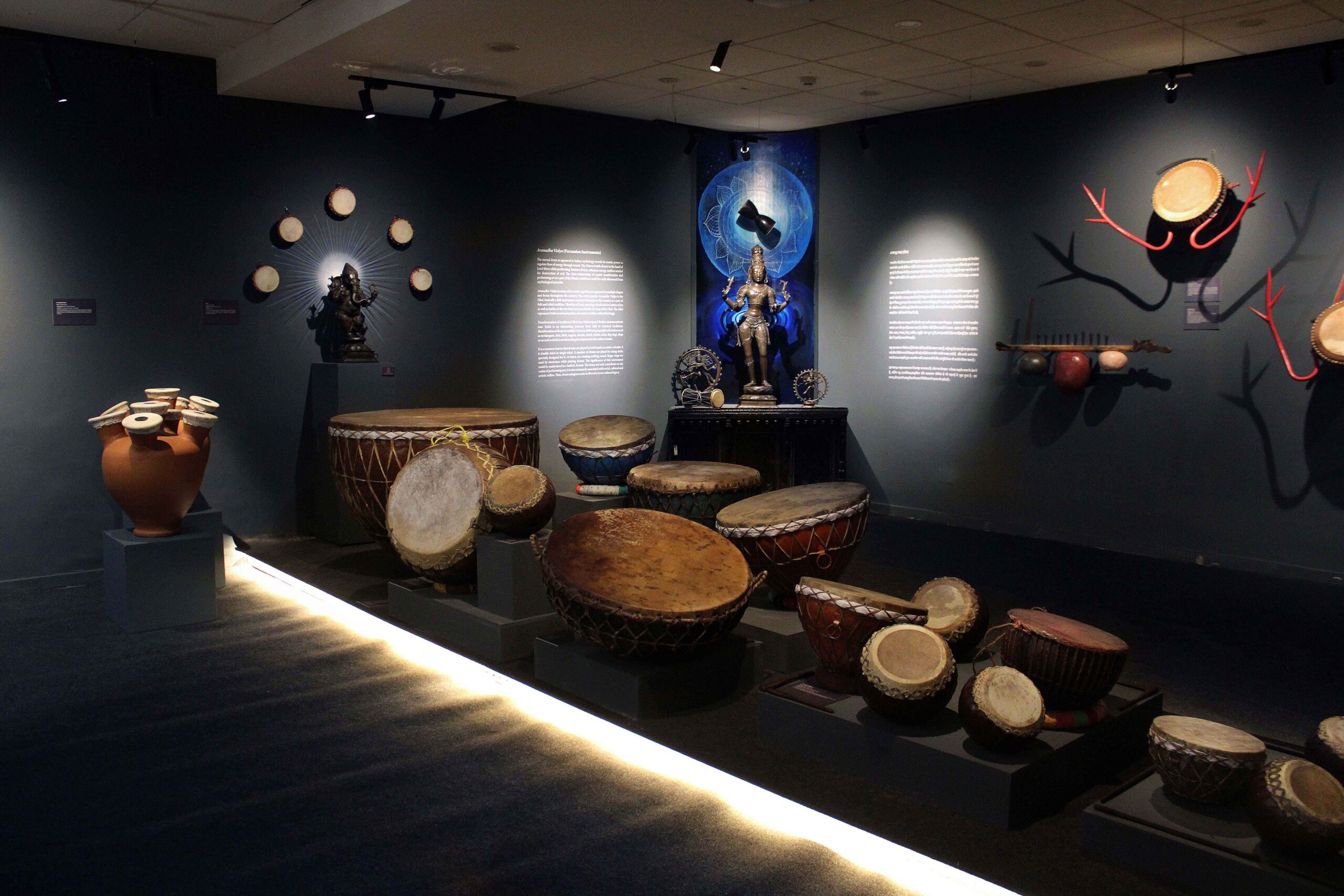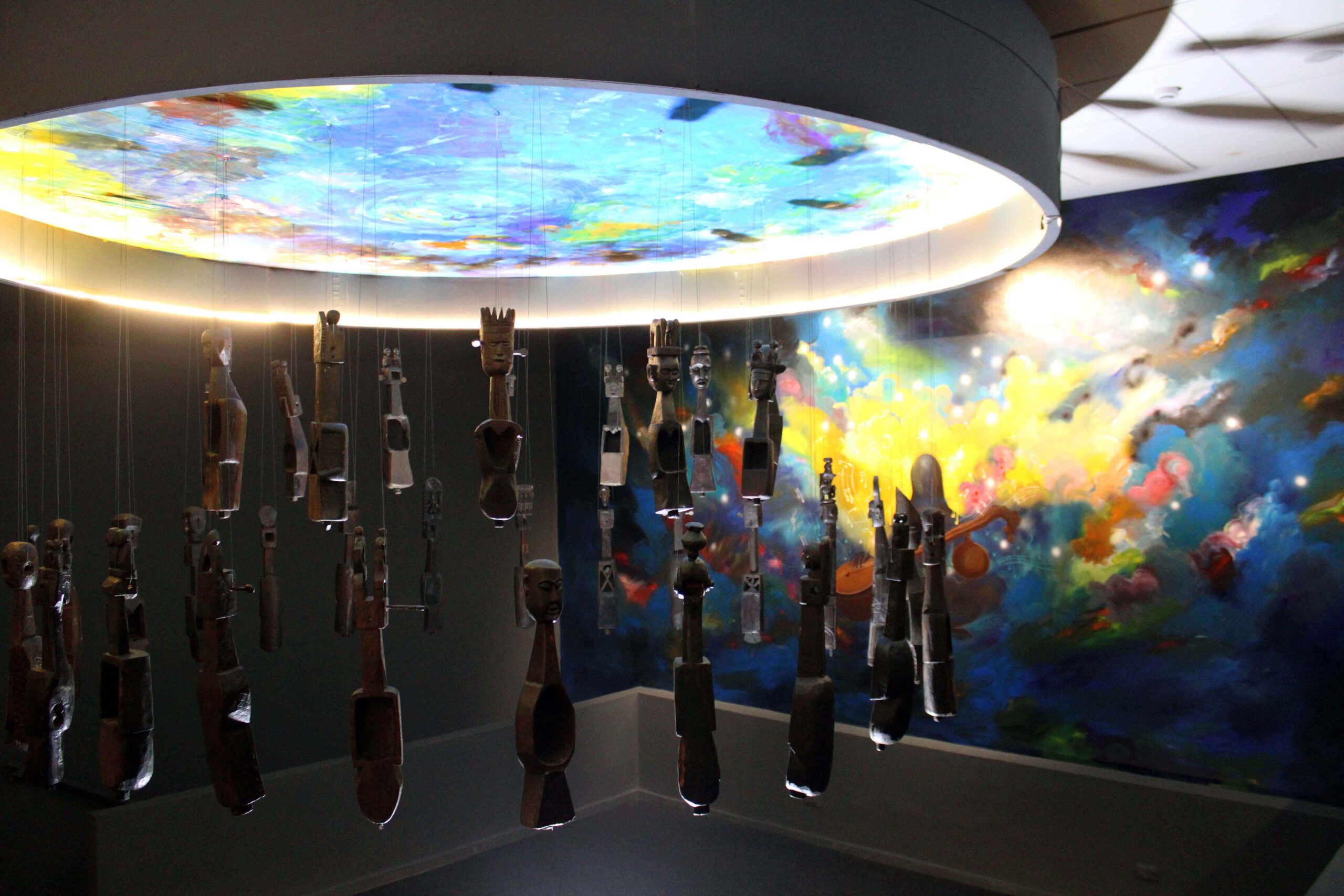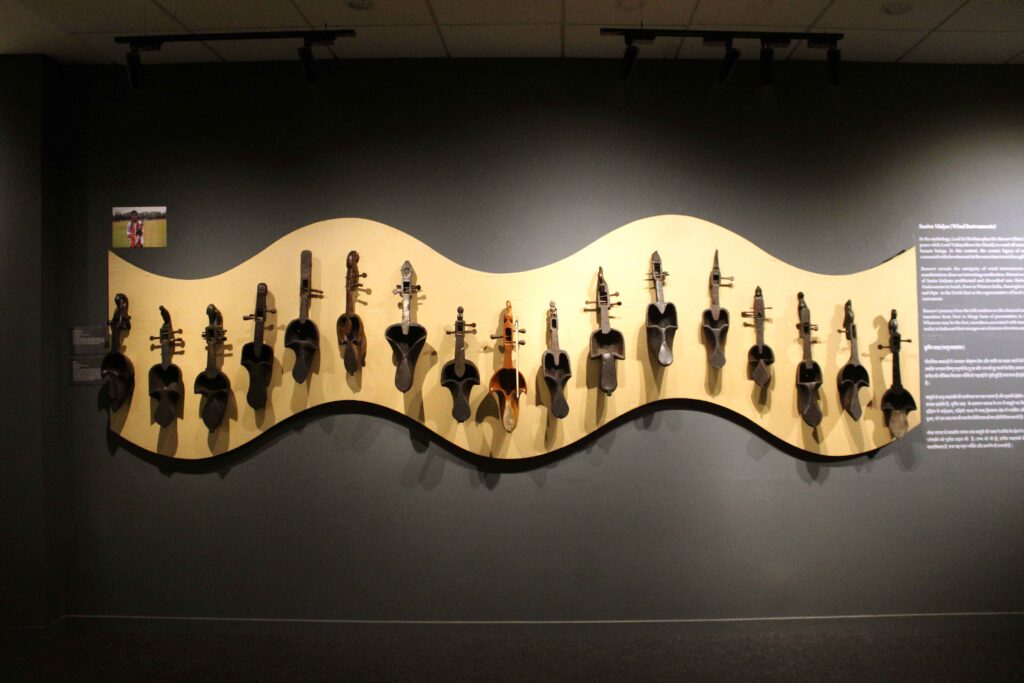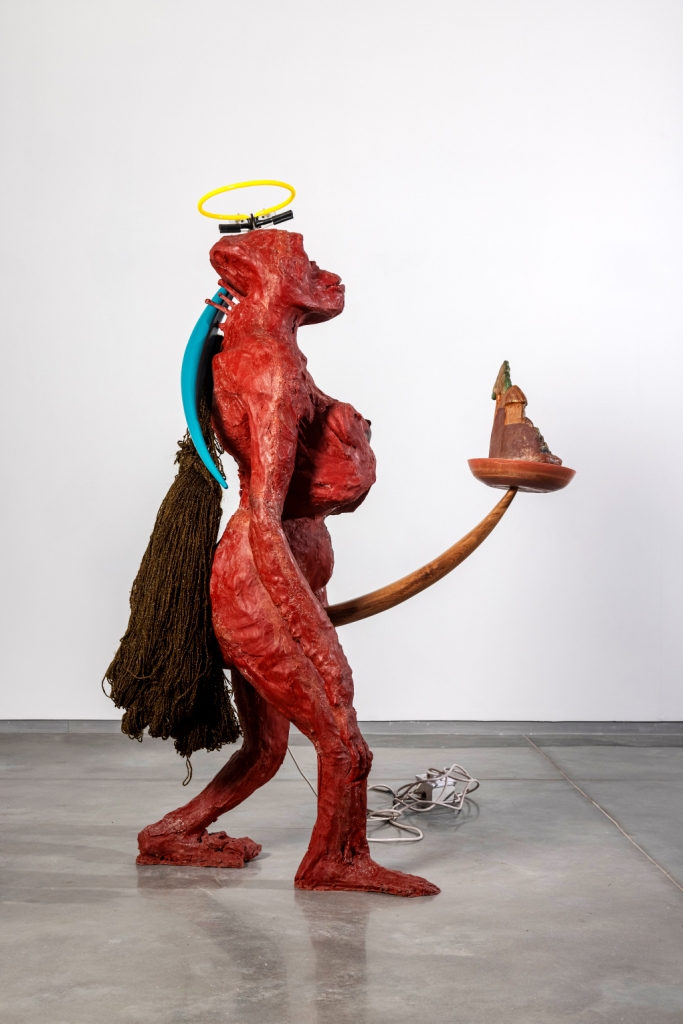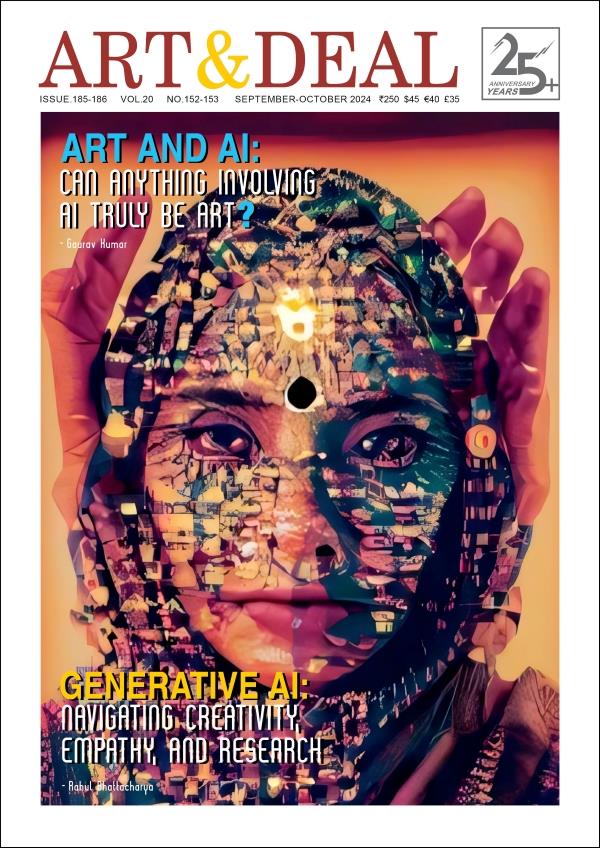As a tribute to the traditional and classical music instruments, an ingenious exhibition titledVādya consisting of Folk, Tribal, and Classical musical instruments from all over India was curated by Ms Nidhi, Deputy Director, Crafts Museum, presented by MATI-Management of Art Treasures of India, in collaboration with National Crafts Museum and Hastkala Academy.
Each musical instrument was almost like a universal component of human culture. Even in the making of the instruments much of the past was revealed. There is a timeless quality in Indian music that radiates a rare cosmic energy. The magic from the sounds created with musical instruments emanates a lyrical mix of enchanting and mystical qualities that are often played at temples. Marriage ceremonies, fairs and festivals, and other social engagements always vibrate with dance and music accompanied by the playing of various musical instruments.
The Basuri from Bastar is a traditional single shaft of hollow bamboo with seven finger holes. Closely associated with Lord Krishna’s flute this instrument has the most melodious and gentle sound.
The Been is a simple folk instrument traditionally played by snake charmers. It is made out of a small gourd with a blowing hole at the top and two attached pipes at the bottom. A sharp, penetrating sound is produced by the reeds for each pipe inside the gourd as it entices the snakes to dance.
The Decca is a five-fretted single resonator chordophone instrument of Odisha that may soon become extinct because there may not be any more players of it post this ongoing generation. It is a Santhal drone instrument that creates a deep, booming sound effect. It is exclusively associated with the Dasae festival of Santhals, which coincides with the Durga Puja of the Bengalis.
The Dholak is a two-headed hand drum, a folk percussion instrument most commonly recognised in India, Pakistan, Bangladesh, Nepal, and Sri Lanka. The drum has two different-sized drumheads, which allow a combination of bass and treble with rhythmic high and low pitches.
An exhibition of this magnitude required the research, understanding, and hard work of several experts.
A Q&A with Mr. Sohan Kumar Jha Director, National Crafts Museum & Hastkala Academy, curator of the Vādya exhibition and National Crafts Museum & Hastkala Academy, Ms Nidhi, Siddhartha Tagorefounder of MATI, Gaurav Kumar assistant curator of the Vādya exhibition, Prof. AK Das Conceptual input for Vādya Exhibition, revealed their journeys.
Uma Prakash: How difficult was it to source these instruments and once acquired to source them?
Sohan Kumar Jha: It was not difficult to source these musical instruments because maximum instruments on display are from the Museum Collection only. A few musical instruments have been sourced from the MATI Foundation, another Institution that collaborated with the museum. Our country has a master craftsperson available to make such musical instruments. To maintain these crafts of musical instruments, the skills of a master craftsperson have been utilised to maintain them.
Uma Prakash: Do you think these instruments will not be available in the future as their demand is diminishing?
Sohan Kumar Jha: The musical instrument on display will definitely be available in the future, but the exact shape and form may not remain the same as they were because of continuous innovations and improvements in Science and Technology and research work to keep the musical instruments original in content but shape and form has changed by the introduction of new technology.
Uma: Did you curate this exhibition of pan-India musical instruments by MATI to project the contribution of each region?
Ms. Nidhi: My idea to curate this exhibition was to bring out little-known aspects of the musical instruments representing some areas of our country. The main emphasis here was to show the emotional bonding of Musical instruments with community life.
Uma Prakash: In today’s fast-moving technology, do you think it will be difficult to preserve these traditional musical instruments?
Ms. Nidhi: Preservation of the musical instrument is a difficult task because of its organic nature. However, digital technology can be employed to preserve the image of the instrument as well as its intangible properties for a long period.
Uma Praksh: What got you interested in folk instruments? Can you tell us the stories that were linked to them?
Siddhartha Tagore: Three incidents made me feel very attracted to the folk andtribal musical instruments. One waswhen I was travelling by train to Assam many decades ago. I saw a Bhaat singer playing a musical instrument, which is a ubiquitous scene on any of these trains. They came and played, and I saw the intricately carved Dotara, which immediately caught my eye. I did not buy it from him, nor did I ask him to sell it. But that was the first incident where I thought I should collect musical instruments. Number two was my visit from Delhi to Calcutta by train, and in the Gaya station, I saw one Bhaat singer again with the same kind of instrument, but it had many utility pockets in the instrument like he had kept his comb and bidis and matchbox in the Dotaras. That is also something I got attracted to.Even though they play music, their utility items are also kept with the instrument. Number three was when I visited Santiniketan. A little ahead of Santiniketan, there is Kenduli, the birthplace of Jayadeva, who composed the Sanskrit poem “Gita Govinda.” Every year, the annual Baul Mela is organised in Jayadeva’s honour in January, where all the Bauls gather. After seeing these kinds of instruments, the idea stuck in my mind, and I decided to collect musical instruments and have an exhibition on them.
Uma Prakash: Your inspiration in this show and the way you are fashioning the MATI projects(sentence not complete)
Siddhartha Tagore: I have been a collector of many artefacts, the collection of musical instruments is one of them, and I have dedicated the past two decades to acquiring these rare musical instruments from the interiors of tribal areas of Chhattisgarh, Santhal villages, Hinjoldoba in West Bengal, and some from the tribal area of Odisha. When I got to know of the rare and almost extinct musical instruments like Tuhila, Panchmukhi baja, Buang, Decca, and Ghasiya Baja, then I thought of exhibiting a unique kind of exhibition on musical instruments. According to me, this type of exposition informs the audience about the many musical instruments, hence increasing appreciation for diverse styles. They also emphasise the workmanship and creative features of the instruments while providing insights into the growth of music and societal values. Overall, musical instrument displays encourage cultural interchange, education, and creative appreciation. This notion inspired me to organise this show, with the collaboration of the National Crafts Museum and Hastkala Academy.
In fashioning The Management of Art Treasure of India (MATI) projects, we prioritize authenticity, sustainability, and community engagement. We collaborate closely with local artisans and cultural experts to ensure that our initiatives are rooted in respect for tradition while also embracing innovation and contemporary relevance. Our goal is not only to create meaningful cultural experiences but also to contribute to the economic empowerment of artisans and the overall cultural ecosystem.
Through exhibitions like Vādya and other MATI projects like Ganika in the visual culture of the 19th – 20th centuries, we hope to spark dialogue, foster cross-cultural exchange, and inspire a renewed appreciation for the richness and diversity of our cultural heritage.
Uma Prakash: What was your contribution to the concept of this exhibition?
Prof. A.K. Das: There is no concept, only emotions splashed with myth, legends, and devotion trying to project through these collections. Exhibition concepts are too stereotypical.They are not my cup of tea. I look at art objects from my heart, not my brain.
Uma Prakash: Tell me about your journey in collecting musical instruments.
Prof. A.K. Das: My journey started in Arunachal Pradesh in the sixties and later continued in Bastar and Koraput in Central and Eastern India in the eighties. The last leg was in Dangs in Western India. My collections are scattered in various museums.
Uma Prakash: When placing the instruments, what kind of ambience did you wish to create?
Gaurav Kumar: Under the guidance of Nidhi, the curator, and the Deputy Director of the National Crafts Museum, we wanted to evoke a sense of cultural richness and heritage by carefully placing the folk, tribal, and classical musical instruments within the exhibition space. Our goal was to create an ambience that honoured the rich cultural heritage and significance of each musical instrument on display. We aimed to foster an immersive and educational experience for visitors, where they could not only appreciate the craftsmanship and beauty of the instruments but also understand their historical, cultural, and musical significance. Therefore, each instrument was strategically positioned to highlight its unique features and cultural significance. We carefully considered factors such as lighting, spacing, and arrangement to enhance the overall atmosphere of the exhibition space and evoke a sense of reverence and curiosity among the visitors, inviting them to explore and appreciate the rich musical heritage preserved within the National Crafts Museum.
Uma Prakash: Did the instruments transport you to another era?
Gaurav Kumar: I had the privilege of closely examining and studying these remarkable instruments. The craftsmanship and intricacy of each piece indeed provided a fascinating glimpse into various historical eras and cultural contexts. As I engaged with these instruments, I couldn’t help but feel a profound sense of connection to the rich musical traditions and stories of the past. Each instrument seemed to carry its own unique narrative, transporting me to different periods and regions, where music played a central role in shaping communities and identities. So, in many ways, yes, the instruments did transport me to another era, allowing me to appreciate the timeless beauty and significance of our musical heritage.
MATI’s Vādya at the Crafts Museum invites the viewer to draw inspiration and strength from the thrill of this exhibition while evoking their cultural and traditional beliefs. This platform allows the viewer to appreciate India’s heritage and absorb its stunningly unique excellence.
Read More>> Please Subscribe our Physical Magazine